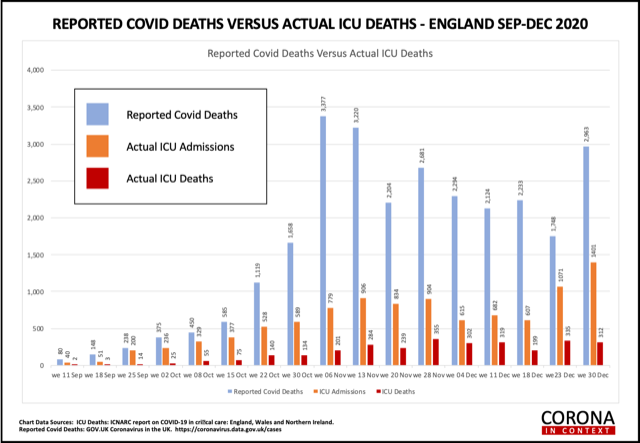
Both hospital admissions, overwhelming some regional hospital’s capacity, and ICU admissions are up by 30% in this last week, compared to the week before Christmas. This means it is possible that next week will see more deaths in ICUs since the average length of stay for non-survivors is 10 days.
As has been widely reported, deaths of those with a positive covid PCR test are up last week, at 2,963. This is lower than two weeks of November and, overall, all December deaths are not much different to all November deaths. Normally, at this time of year there are 10,000 to 12,000 deaths overall a week. The big problem is not knowing how many deaths of those with a positive PCR test are from covid rather than with covid. With hospitals overwhelmed some people will not get the critical care they need for other life-threatening conditions.
Although the new virus strain appears more contagious it is not yet clear if this will translate into more risk of mortality. The fear is that it will and ICUs will be overwhelmed. At the peak of the first wave, in April, there were circa 3,800 in ICUs out of a capacity of circa 4,122. Currently there are 2,228 people in adult ICUs. While this appears to show ICUs are at half capacity some regions will be ‘full’ while some ICUs have no or very few covid patients. Given this potential for overwhelm it is extraordinary that the UK government still ignore inexpensive, easy to implement covid prevention steps.
There are seven evidence-based prevention steps and so far most governments have only acted on three of them (masks, social distancing which includes lockdowns and vaccinations). I’ll explain the other four, and estimate the impact they could be having, in a report. Combined, they could cut risk of death by 90%. Make sure you’re signed up to my free e-news on the home page of this website to receive this.
Vaccinations, according to the Pfizer and Oxford/AstraZeneca trials, cut the risk of developing covid symptoms, by 70-95% – call it 80% as an average. (One dose of the Pfizer vaccine is reported to be 52% effective). But what many people don’t realise is that, out of 24,027 in the control/placebo groups of these trials only 273 became infected. In other words, 99% did not. So that combined efficacy of approx 80% means that if you were in that 1% who would have got infected you’d get 80% protection. So, if you vaccinate a million people, 990,000 would not become infected anyway, and of the remaining 10,000 who would have become infected/symptomatic, 8,000 would be protected. Currently, the mortality rate in the UK of those who become infected is 3% (there have been a quarter of a million tested positive and 73,512 deaths of those testing positive). That means that 3% of the 8,000 equates to 240 lives saved if a million people are vaccinated.
The reality may be better (or worse) than this. We do not know yet. In these two vaccine trials no covid deaths were reported in the Pfizer trial and one was reported in the Oxford/AstraZeneca trial, in the control group. Combined, these studies involved 46,000 people of which 24,000 were vaccinated. So that’s potentially one life saved so far with 24,000 people vaccinated. One would hope these results would improve because, with more people vaccinated the R number would fall so there could be a beneficial knock on effect. We will have to wait and see if this turns out to be true. I do hope so.
Whatever the figures may turn out to be, which we will only know in six months or so if enough people get vaccinated, this is a costly strategy for a seemingly small benefit.
As you’ll see in my ‘Seven Scientifically Supported Steps to Prevent Covid’ the so far ignored other four steps are much easier to implement, less costly and have no risk of serious adverse effects. These four steps can be done alongside the current three step dance – masks, social distancing and vaccinations. The big anomaly is why are our governments ignore the evidence of these other four, while both funding and going gung-ho on the limited evidence for vaccinations? These other four, as you will see, actually have more evidence of effect and have not only received virtually no research funding, but have been largely ignored. I’m talking about vitamin CWhat it does: Strengthens immune system – fights infections. Makes collagen, keeping bones, skin and joints firm and strong. Antioxidant, detoxifying pollutants and protecting against…, vitamin DWhat it does: Helps maintain strong and healthy bones by retaining calcium. Deficiency Signs: Joint pain or stiffness, backache, tooth decay, muscle cramps, hair loss…., zincWhat it does: Component of over 200 enzymes in the body, essential for growth, important for healing, controls hormones, aids ability to cope with stress… and Ivermectin. Read my Covid News January report on this.

Comments
Join the Conversation on our Facebook Page